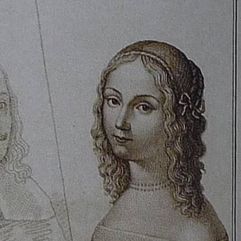

Elisabetta Sirani
1638 - 1665
Elisabetta Sirani was an Italian Baroque painter and printmaker who died in unexplained circumstances at the age of 27. She was one of the first women artists in early modern Bologna, who became a successful painter, producing public altarpieces as well as privately commissioned pictures.
Life
Elisabetta Sirani was born in Bologna on 8 January 1638, the first of four children of Margherita and Giovanni Andrea Sirani. Giovanni was an art merchant and painter of the School of Bologna, having been a favorite assistant of Guido Reni. He did not produce many works during his lifetime; instead, he took over Reni's job as a teacher, and became the master in the first life school held in the house of Ettore Ghislieri.
Sirani first trained as a painter in her father's studio. There is evidence that Giovanni was not inclined at first to have his daughter as a pupil, but she picked up his technique nonetheless and became one of the most renowned painters in Bologna. The art biographer Carlo Cesare Malvasia, a personal acquaintance of the Sirani family, claimed credit for recognizing Elisabetta's talent and persuading her father to train her as a painter, although this was likely self-aggrandizing.
Sirani's biography is included in Malvasia's two-volume Felsina pittrice: vite de'pittori bolognesi, or Lives of the Bolognese Painters, first published in 1678. She is presented therein as the epitome of Bolognese genius, and Malvasia takes much pride in his (alleged) contribution to her early career. Throughout, he praises the originality of her compositions, her style of drawing, her fast manner of working and her professionalism, contrasting her with Lavinia Fontana, an earlier Bolognese woman painter whom he describes as timid.
In establishing her painting style, Sirani studied the works of Annibale Carracci, Lorenzo Pasinelli, Desubleo, Simone Cantarini, and Cignani. Along with technique, her early education included outlines of Bible history and the legends of saints, as well as Classical mythology. Sirani received her first commission in her teens, a Baptism of Christ, which was a companion piece to an earlier done painting by her father at the Campo Santo of Bologna. She was also knowledgeable in music, one of the reasons being that her brother-in-law was a musician.
According to some scholars, Sirani's artistic reputation soon overshadowed that of both her father and her two sisters, who were also painters. By 1654, Giovanni Andrea Sirani became incapacitated by gout, so Elisabetta began running her family's workshop. At this point, she was the household's primary breadwinner, supporting the family with her teaching fees and portrait commissions. Her studio was highly successful, partially due to the progressive atmosphere of Bologna, where women artists were accepted and celebrated.
Text courtesy of Wikipedia, 2025
















